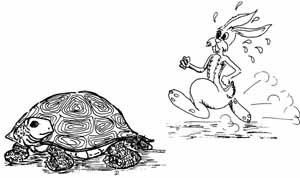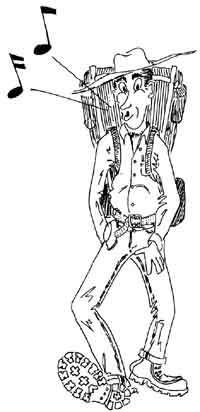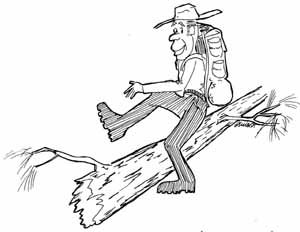Most people think that just because they were born into the bipedal human race, they can walk well. Not so—many people walk poorly and inefficiently. Between your front door and your garage it doesn’t matter much, but on the trail it matters a lot.
If you’re more than three years old, some of your walking habits are now impossible to change, but if you work at it you can learn at least two good hiking habits: start slowly, and walk rhythmically.
The story of the tortoise and the hare could have been written about trail-hikers. Those few hikers who are able to hold them selves down to a plodding pace from the very beginning eventually overtake all the “off-and-running” types, and are the first to arrive in camp. (Of course, I am not including comparisons of sixty-year-old desk-bound weekenders with twenty-five-year-old professional athletes.) .
How fast you should go—your pace—depends on your body’s strength, the load you are carrying, the distance you plan to cover, the time available to cover it, the steepness of the trail, the nature of the trailway and your mood that day. There is some trade-off between body strength and load. If you have exercised before your trip to get in shape, you can carry more pounds at a given speed; if you haven’t exercised, you can go at that speed if you carry a lighter pack.

Fig 8-1
A person in poor physical condition can hardly carry any load at all, so it is important for you to condition your body in advance. Many Americans in their regular daily activities stay in good condition, but most do not. Those who don’t must make the effort—and take the time—to exercise. The best exercise for hiking is running.
Walking is also excellent conditioning for hiking, but it takes much longer to get the same benefit from walking that you get from running. On the other hand, if there are nice places to walk near where you live or work, the pleasures of walking there make up for the extra time required. I find that when I’m walking along streets and roads where I have driven hundreds of times, I see many things I never saw before. Carrying a loaded pack while you take practice walks increases the benefits of the exercise.
Given your strength, your load, the distance, the time, the steep ness and your mood, the proper pace for you is one that you can maintain hour after hour. Some people say that if you can’t carry on a conversation you are going too fast, and I more or less agree.
The second requisite of successful hiking is a steady, rhythmic pace. You will need many miles of conscious practice before you can leave to your body the job of keeping in time with the March of the Happy Hiker. The tempo of this march varies: andante on the level, allegro going downhill, lento going up. Eventually the drummer who keeps the cadence in the back of your mind will learn to make the proper variations as needed. Some times a beat is syncopated, when just before landing on your for ward foot you see a better place to place it, and you move it quickly there.

Fig 8-2 A happy hiker in tempo
Going Uphill
Besides being in shape, there are a few tricks that make steep uphill walking easier. First, keep your foot flat on the ground as long as you can before rising onto your toes and lifting the foot forward. (This advice is also good for walking on the level, but more important going uphill.) Second, breathe in rhythm with your footsteps—two or four or six or eight steps per breath, de pending. Third, when either your lungs, due to thin air in high elevations, or your legs, due to exertion, need rest, use the rest step. Advance one foot to a new position. Then lock the rear leg and relax the advanced leg. Pause a short moment. Finally, put the advanced leg to work again. The pause may last only a few microseconds, but it will do wonders for your ability to keep going. One final trick for steep uphill walking applies only to off-trail hikes; when the slope strikes you as too steep, start making your own switchbacks.
Going Downhill
It is disappointing that, after a stiff climb, you cannot simply put your gears in neutral and coast down the other side. But the fact is you have to apply the brakes. Going downhill is when blisters are most likely to develop, ankles to be sprained, toenails to be scrunched, and knees to turn to jelly. The defense against blisters and sprains is to tighten your boots, and maybe add a pair of socks. The defense against scrunched toenails is to cut them before the trip. The defense against jellied knees is to go slowly and take enough rests. Don’t go so fast as to jar a headache into existence, and don’t have your advance leg absolutely straight when you shift your weight to it.

Fig 8-3: Step over, not on
All the Time
Never step on a rock or a log if you can step over it. A broken leg or a sprained ankle in the wilderness creates major problems. Besides, it takes more energy to mount the obstacle, and the step down jars you more. (In rattlesnake country, of course, you won’t put your foot down where you can’t see.)
Rest Stops
How often should you stop, and for how long? Frequent short rests are the best, for a simple physiological reason. What makes your muscles tired is that they accumulate lactic acid, a chemical result of exertion. Two 5-minute rests per hour will decrease the lactic-acid concentration better than one 10-minute stop. Depending on all the things that affect proper pace, I stop for 3 to 6 minutes every 20 to 60 minutes. I also eat or drink something at every stop, be it only a lemon drop or a sip of water. Most beginners go far too long without eating or drinking.
You should not even start out until you are entirely comfort able, especially your feet and your back, where the pack bears on it. But even so, you will need a “shakedown” rest stop after about an hour, to adjust boot laces, pack, belt and clothing. This rest should last longer than 3 to 6 minutes, perhaps 20 minutes. On a hard day’s hike, you will need several longer rests—besides the lunch stop—of up to 15 minutes. If they get longer than that, your body will cool off too much, and anyway long rests are a sign that you are going too fast.
After any stop, look around carefully for anything you may have set down and forgotten. Walking about 2 miles—a round trip of 4 miles—to retrieve a camera you hope is still there is well worth avoiding. It’s best never to put anything down on the ground even for “just a second” if you have a pocket, sheath, loop, or whatever to put it in.
Up to now in this section you have been walking alone, but that will seldom be true. Since different people march to different drummers, some will seem to be stragglers. The leader or the deputy should go last, to make sure everyone gets to camp, but no one should criticize anyone else’s pace or bow to criticism of their own pace. Finally, don’t tailgate. There’s plenty of room on the wilderness highway, and people go there to get away from the overcrowding of the city.
Having considered your physical needs when walking, now consider the effects of your feet on the landscape. On a trail, your passing will have very little effect; off-trail is where damage be gins. The effect of walking one time across untrammeled ground may seem negligible, yet it can take years for plants and soil to recover from your steps, especially in arid areas, at high altitudes, on steep slopes, and in meadows. Footsteps damage plant foliage and roots, compact the soil, and invite erosion on slopes. One trip across a sensitive area may encourage others, seeing your footprints, to follow, leading to an unnecessary and damaging new trail. Even your footwear makes a difference, as a heavy- soled boot makes a deeper gouge in the earth than a lighter boot. The conscientious hiker will not shortcut trail switchbacks, will try to walk on rock instead of plants, and will avoid meadows and wet areas when possible. When crossing a sensitive area in a group, spread out instead of following one behind the other, to disperse the impact of your passing.
PREV: Trailhead Tips
NEXT: Camping Techniques
All Backpacking articles
© CRSociety.net